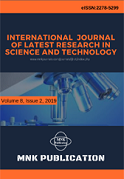DOI:10.29111/ijlrst ISRA Impact Factor:3.35, Peer-reviewed, Open-access Journal
Research Paper Open Access
International Journal of Latest Research in Science and Technology Vol.3 Issue 6, pp 33-36,Year 2014
Correspondence should be addressed to :
Received : 14 December 2014; Accepted : 24 December 2014 ; Published : 31 December 2014

| Download | 125 |
|---|---|
| View | 180 |
| Article No. | 10418 |
On paper, we have prepared TiO2/MPA/CdSe/ZnS by Successive ionic layer adsorption and reaction (SILAR). The results show that a signiï¬cant improvement of the light to electric power conversion efficiency of quantum dot sensitized solar cells with a polysulï¬de electrolyte which can be achieved as using bi functional surface modifiers (SH-R-COOH, Mercaptopropionic acid (MPA)). The injected charge carriers in a CdSe-modified TiO2/MPA film can be collected at a conducting electrode to generate a photocurrent. The TiO2/MPA/CdSe/ZnS composite, employed as a photo anode in a photo electrochemical cell, exhibits a photon to charge carrier generation efficiency η, the short circuit current JSC, open circuit voltage VOC, and ï¬ll factor FF correspond to 0.909 %, 6.67 mA/cm2, 0.43 V, 0.31.
Copyright © 2014 H. T. Tung et al. This is an open access article distributed under the Creative Commons Attribution 4.0 International (CC BY 4.0) license which permits unrestricted use, distribution, and reproduction in any medium, provided the original work is properly cited.
H. T. Tung , " Harvesting Light Energy With Cdse/ Cdse (silar) /zns (silar) Nanocrystals Molecularly Linked To Mesoscopic Tio2 Films For Quantum Dot Solar Cells ", International Journal of Latest Research in Science and Technology . Vol. 3, Issue 6, pp 33-36 , 2014

MNK Publication was founded in 2012 to upholder revolutionary ideas that would advance the research and practice of business and management. Today, we comply with to advance fresh thinking in latest scientific fields where we think we can make a real difference and growth now also including medical and social care, education,management and engineering.

We offers several opportunities for partnership and tie-up with individual, corporate and organizational level. We are working on the open access platform. Editors, authors, readers, librarians and conference organizer can work together. We are giving open opportunities to all. Our team is always willing to work and collaborate to promote open access publication.

Our Journals provide one of the strongest International open access platform for research communities. Our conference proceeding services provide conference organizers a privileged platform for publishing extended conference papers as journal publications. It is deliberated to disseminate scientific research and to establish long term International collaborations and partnerships with academic communities and conference organizers.